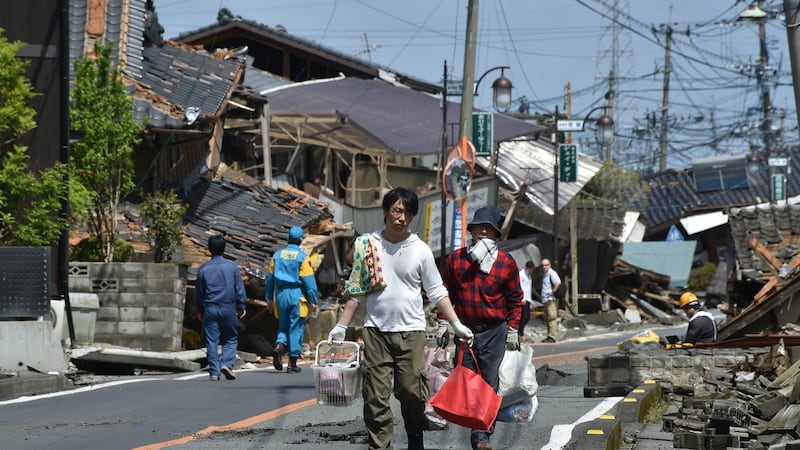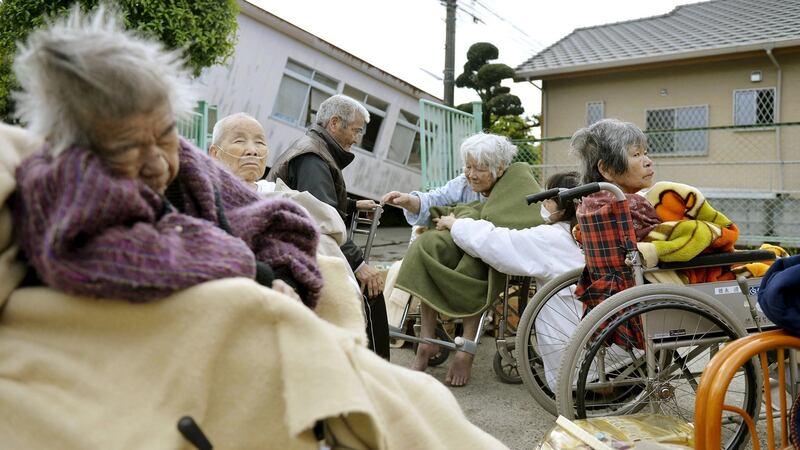On the floor of Kumamoto city hall, the old and young lie side by side on makeshift beds, praying for a few hours of unbroken sleep.
“I thought the earthquake would bring the roof crashing down,” says Yoko Yano, who fled her home. “I can’t go back there.”
She shares a small corner of the crowded floor with Reiko Miyamura, her elderly friend.


“We were in a primary school gymnasium when the second quake struck,” Yano recalls. “The shaking was so strong it was terrifying; we slept outside in the cold, wrapped in blankets.”
Across this city of 730,000 people, thousands are spending another night huddled in schools, community halls and in parked cars. Water is delivered in tankers and hot food is scarce.
In an area once thought relatively safe from the seismic threats that plague the rest of Japan, local people have been stunned by the events of the last few days.
Many fled their beds in the early hours of Saturday after the second of two powerful quakes struck in as many days.
The epicentre was near the city at a shallow depth of about 10km – making the shaking feel urgent and intense.
"I'd rather be here, safe, than under a shaking roof," said Kazuyo Nakamura, who is spending the night in the family car with her husband.
Hundreds injured
At least 41 people have died since the first 6.4-magnitude quake on Thursday. Hundreds more are injured, some seriously, according to NHK. Many were hit by falling objects or crushed under buildings. More than 110,000 people are temporarily homeless.
Just east of Kumamoto city, rescuers are working through the night to search for survivors in the rubble and mud of Mashiki, a town of traditional wooden houses, many them collapsed.
More than a dozen people are missing or unaccounted for, says Kyodo News. Landslides triggered by the quakes have carried away roads, railways and homes, cutting off some remote villages. At least one dam could be at risk of collapse.
Already jangled nerves have been rattled by aftershocks that continued throughout Sunday night. “People are too scared to return home,” says Shuji Furusho, an official with Kumamoto city. “There’s shaking every 10 minutes or so.”
No water
Prime minister
Shinzo Abe
has sent some 25,000 troops, firefighters and other personnel to help with rescue work and distribute supplies. Most of Kumamoto’s households are without water, says Furusho. “That’s our biggest issue.”
Japan's only operating nuclear plant is about 120km south of the city. Kyushu Electric Power Co, owner of the Sendai nuclear facility, said it was unaffected by the quakes.
The country's entire fleet of nuclear reactors was shut down in the months following the 2011 triple meltdown in Fukushima, which was triggered by a huge earthquake and tsunami.
The Kumamoto quakes are likely to renew the country’ as some know it may not be possible. Next week city officials will begin the task of going door to door to condemn unsafe houses.
Yano’s home is 100 years old. She says it is unlikely to survive.
“We watched the disaster in Fukushima and feared our turn would come one day,” she says. “But nobody really expected it in our lifetimes. It’s really hard to bear.”










